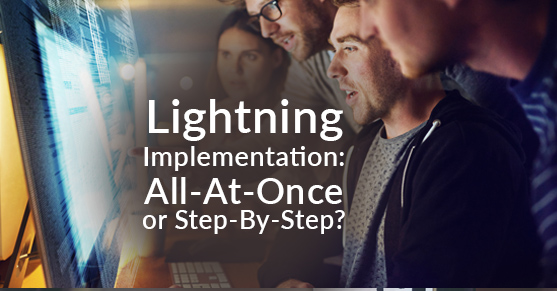So your sponsor is backing up the Lightning transition, your team is onboard, and all you have to do now is decide on your strategy. There’s a number of different ways, but typically you’ll either phase Lightning in or do it all at once. Which of these paths you choose depends on several different factors — for example, the size of your user base or intricacy of your applications — and we’d like to highlight those.
What’s right for you?
When it comes to implementing the Lightning Experience in a phased approach, it’s probably better to do for big businesses. When you have a lot of users and a lot of integrated applications, gradually transitioning to Lightning is the way to go. It allows you to strategically handle various technical and business requirements at a steady pace, collect feedback after each phase, and fine-tune the process. Each phase offering the opportunity to learn and being more successful than the last.
In contrast, an all-at-once approach is more suitable for smaller organizations with less complex configurations and fewer users. At its base, rolling out Lightning all in one fell swoop can be the simplest way to change interfaces. Yet, changing interfaces in this way requires you and your team are all very prepared for Lightning and each person gets what the need out of it. Whether you do it this way or incrementally, as we’ve mentioned before, the need for significant planning, training, and teamwork when rolling out Lightning is paramount to a successful implementation.
The Benefits
Now that we know which options work best for certain businesses, let’s take a look at some of the concrete benefits of each style.
All-At-Once Implementation Benefits:
- Managers will more than likely lean toward this option because it’s simple. The training is done as a team, the user groups and BU leaders are on board, and then you transition your Salesforce interface from Classic to Lightning. If everyone is on the same page then all will go well.
- All at once, every user gets to reap the benefits of the Lightning interface — as well as new technology as it’s released — and interacting with new applications and customizations will be a team effort. Whenever something new comes along, you and your team will handle it together, offing group evaluations of products and the opportunity to improve as a team.
Phased Implementation Benefits:
- The best way to complete a puzzle is by doing it in blocks; the same goes for transitioning your users to the new interface. When you break up implementation into multiple phases, you’ll minimize technical debt and make significant progress with each area you’re focusing on. As new features and improvement upgrades are released, you’ll see less falling behind and more moving forward.
- When implementation is done step-by-step, you’ll be able to gain perspective on the product, concisely evaluate the needs of your team, and be more prepared as Lightning sweeps through your organization. One of the steps is a pilot program, which offers the opportunity to run acceptance tests, gather feedback, and build a structurally sound strategy for when the interface goes live to each user.
What to Consider
Before jumping into either method of implementation, take some time and consider potential weak points. With these considerations in mind, you’ll be prepared for whatever comes your way.
All-At-Once Approach Considerations:
- Rolling out the Lightning Experience in one move means there’s no time for a pilot session or constructive feedback, which makes more room for error. You could potentially look over some sort of technical issue or necessary team aspect to address.
- There’s significant preparations needed for an all-at-once rollout, so it might not be as timely as you or your team would like it to be. Training, implementing business processes, and attending to technical issues, though beneficial, will hinder your implementation and a timely transition might not be realistic.
- Updates and new features are rolled out pretty consistently from Salesforce. Without a smooth transition and organization-wide acceptance, you’re at risk of getting behind on the new additions and improvements.
Phased Approach Considerations:
- When you’re analyzing technical gaps be sure to exclude the affected teams of that particular phase while you address the issue at hand. Though some gaps might be small, their impact on your initiative could be huge.
- If certain teams generally work closely together, include them in the same phases. This will help with current and future collaboration and group understanding.
- Communication during a phased approach needs to be very strong. The span of time between phases will more than likely increase the amount of training sessions you’ll have to conduct and changing management activities could become more frequent.
At the end of the day, we’re not trying to tell you how to roll out Lightning. Instead, we want you to have the best experience introducing Lightning and get the most success while using it. If your implementation plan is optimized for your organization, then benefitting from the Lightning Experience will come naturally.
For more information on Lightning, Salesforce, or CRM in general, be sure to read our blog. And feel free to reach out to remoteCRM, powered by XTIVIA, for all your Salesforce needs and services. We’d love to help you improve your business.

